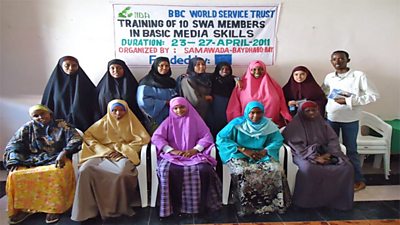Downloads
Publication date: July 2012
Summary
- Somali audiences enjoyed the content of ����ý Media Action’s EC-funded radio programme Hayaanka Nolosha. They thought the programme delivered interesting and relevant information and said they had discussed what they have learned from the programme with family members and friends.
- Both men and women liked the focus on the role that women can play in governance issues like peace building, and wanted women to be more involved in these processes in the future.
- Face-to-face and online journalism training increased journalists’ practical knowledge, but more support is needed for them to better apply this knowledge in their work.
- Our training improved the confidence of civil society organisations but they would benefit from further training to get the most out of working with the media.
Context
There has been civil war in Somalia since 1991 and this difficult political situation has affected the media environment. Radio is the main media platform throughout Somalia. Due to lack of infrastructure, large-scale print media is only available in Somaliland. As a result of the political context, the number of radio stations in operation changes constantly, negatively affecting the consistency and content of programming. Despite this, a large number of media organisations operate in the country, and the status of journalists among ordinary people is generally high. Earlier research conducted by ����ý Media Action in Somalia also found a high demand for news and development-focused information amongst audiences.
The project
Funded by the EC, the ����ý Media Action programme Hayaanka Nolosha (Journey To A Better Life) was a 30-minute weekly interactive radio programme aired on the ����ý Somali Service from May 2011 to May 2012. It aimed to create awareness of human rights, governance issues, gender equity and peace among Somalis. In addition, media professionals were trained in technical skills, interviewing and editing skills, how to report in a fair and balanced way, use of appropriate sources and working in an insecure area. Civil society organisation (CSO) representatives in Somaliland were shown how to collect information from various sources, mediate effectively with the media, write press releases and hold press conferences.
Research methodology
Focus group discussions across Somalia explored income generation and peace building (two programme content issues), and how the programme had affected audiences’ lives. Journalists, producers and CSO participants were interviewed to find out how much they had learned as a result of the training and to what extent they were implementing the skills they had learned.
Findings
Audiences from all regions of Somalia enormously liked the Hayaanka Nolosha programme and the majority of interviewees felt the programme was relevant to many parts of their lives. The majority of interviewees wanted the programmes to continue and many felt that they should be given more air time.
Journalists, producers and Somaliland CSOs representatives said the training had given them increased skills and confidence to apply them. The majority of journalists mentioned the importance of following key journalistic principles such as using multiple sources for programme content and engaging with feedback from audiences. Some CSO representatives had taken part in interviews or prepared press releases since the training.
However, more could be done. Government representatives and NGOs were still the sources most frequently interviewed by journalists, who faced challenges in engaging with CSO members due to security issues and limited CSO knowledge about how to engage effectively with the media. Many CSO representatives themselves lacked opportunities to apply the training in their work environment, and further training could teach them to create those sorts of opportunities in the future.
Implications
Research showed that Hayaanaka Nolosha is a popular, well-liked programme that is relevant to audiences. The audience’s ability to articulate clear learning from the programme suggests that magazine programmes aimed at peace building and human rights through a variety of formats can have a positive impact.
Longer term strategies for media engagement and trust building between media and CSOs are required to provide real opportunities for practitioners from both groups to apply knowledge and skills learned from training provided by this project.
Some journalists felt unable to apply the training in their work. Further support in doing so might make engagement between these two groups become common practice. Future projects could support CSO representatives to deliver further training to others.
